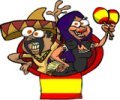Studying languages with Flashcard use...
and 4 important accelerated learning hints so you BEST use them...
and 8 other powerful reasons they should be part of your learning
The use of the flashcard system in language learning is an extremely efficient method of studying language concepts and foreign vocabulary and one which I have used for many, many exams in many different topics.
Done right it is far more effective than many other forms of study, and in fact is one of the very best uses of your study time.
A flashcard is simply a small card with a fact or point of learning on it.
Step 1: How to get the Flash Cards
You can go and get flash-cards from many different suppliers of educational and training or learning.
Just type into any search engine the terms: flash card, flash card creator, or maker or any of a number of similar terms for a huge selection.
or you can:
- make your own ‘learn Spanish flashcards,’
- make your own ‘learn French cards,’
- make your own learn ‘German flash cards.’
Get a reasonable weight of paper and cut them up with scissors or guillotine.
What I find is ideal is to go to your local office supplies or paper merchant store, and buy several sheets of card in several colours.
Ask them to cut them in to blocks, about business card size, or thereabouts. They should fit into your pockets, so don’t get them too big.
Each different colour will be used for a different topic of your choice. Go for lighter pastel type colours so that they are more easily readable.
So for example, if you are learning Spanish;
- yellow may for Spanish grammar.
- blue may be for Spanish verbs.
- green cards might be for Spanish proverbs.
- white cards may for Spanish adverbs.
- pink for Spanish adjectives.
Step 2: Writing your learning Spanish Flashcards - French, German, Welsh, Italian & other languages
The key to efficient learning using flash-cards is to convert all the material you have into questions and answers.
Many years ago I used to study by writing notes on clean pads of paper, summarising page after page of my lecture notes, textbooks and university topics.
Going through the notes repeatedly and rewriting them, the material would sink into the subconscious through writing, repetition and rereading.
However I went on an accelerated learning course and learned the much more efficient method, which was the use of flashcards.
So rather than write notes on all these topics I would go through and convert all the major points of the text into questions and answers. It is no good just stating a fact on a card.
It must be in Question-Answer form, because by putting a question you are forced to think for the answer.
Most people cannot just read something and remember it. Just those lucky few with photographic memories!
So....
Write the question on one side of the flashcard.
Write the answer on the other side of the card.
Step 3: Using the Flashcards
When your cards are ready, grab a pocketful of them and start with any of them anywhere! You don’t need to start in any particular order, just fire away with random questions from anywhere.
Read the question, then try for the answer.
Now this bit on flashcard learning is critical.
whether it be for language learning or any other kind of learning
Flashcard Accelerated Learning Hint #1
If you get the question right…
put the correct (=right) card into your RIGHT pocket. (i.e. get it right put it in the right…)
If you get the question wrong…
put the card into your LEFT pocket.
When you get to the end of your pile, work only on the cards in your LEFT Pocket, the ones you got wrong.
Keep going through the (wrong) flashcards in your left pocket, one by one, and putting them into the respective pocket. Those you get right, put them in the right pocket.
Flashcard Accelerated Learning Hint #2
Treat any hesitation or error as a ‘wrong’
Treat any hesitation or error as a ‘wrong’
Those on which you even hesitate, are not sure of, did not really answer strongly and positively, treat as being wrong.
If there is any doubt when you ask the question, treat it as a wrong answer and put it into the left pocket.
Keep working on those in the left pocket until they are all in the right pocket.
(...so the corollary hint is to ensure you have enough pockets in your shirt/trousers/dress/suit/handbag/rucksack... etc)
This way you are concentrating on your learning weaknesses, while supporting your strengths.
Now start again, or move on to another pile of flashcards.
Once you have finished your piles of cards
Don’t put them away. Start again. Each time you will do them you should be quicker and quicker.
Accelerated Learning Hint #3
Write flashcards regularly throughout
your course
The best way to make your cards is to do them as you progress with your course.
Every day or every couple days, just write a handful of the main points on to flash cards in Q&A form. This is much better than waiting for a last-minute cramming session.
It only takes a few minutes here and there, and over time you quickly build up a big pile of cards.
Accelerated Learning Hint #4
Keep to one question per card
Don’t overload each card. Keep it to one question and answer per card.
In the case of an a question with five answers, by all means have the 5 answers on one card, but make 5 individual cards with the rest, each with an answer.
Of course each student will know how much s/he can handle but use this as a general rule, to keep the chunks of learning to ‘bite-size’. Remember you can only eat an (metaphorical) elephant one bit at a time.
How to write flashcards in a computer so that you can print them out
If you are savvy with a computer you can write questions and answers in to columns on a computer then print the two to a sheet of stickers which you can then peel off and put on to smaller cards.
Most computer printers have difficulty printing to a card, or a sheet of card as the card thickness is usually too big for the printer.
So print each Question and Answer to a sticker that is just under twice the size of the card. Have the question limited to one half of the sticker and the answer to the other half.
Once printed, you can peel each sticker and fold it over so that the question is on one side and the answer on the other.
OR you can print to a sheet of paper, cutting and pasting the Questions and Answers. The trouble with paper is that it is not very rigid, and your cards are not really cards, and get easily damaged.
You can of course glue them to small cards, about business card size.
8 more powerful reasons you should learn with flash-cards
- you can keep them forever and use them in a month, 3 months, a year, 5 years! Great for revision.
- flashcards are easy to carry around.
- you can really concentrate on your weaknesses by going over and over those cards you get wrong. Keep them in the left pocket.
- you can grab a card if you have a 20 second break while sitting on the train, or waiting for the doctor, because it only takes that long to read a question.
- you can get someone to read you the questions from the cards, and test you on the answers almost anywhere.
- you hammer your weak spots and can have them identified…
- you see your progress as the size of the pile in the left pocket (wrong answers) reduces.
- you can build up a pile of cards, steadily over time.
Enjoy your flash learning with language cards.
200 Words a Day! Flashcards
Electronic flashcards (e-Flashcardz) are incorporated into all the 200 Words a Day courses and are an ideal learning companion software system to use alongside the cartoon memory triggers of the system. The e-Flashcardz can be used as a stand-alone learning system, or used in association with the 200 Words a Day! courses. Each course is a Windows based software program that has over 1,000 colour photos and pictures. Each word has a unique photo, text of the foreign word, and a voice-over of the foreign word, spoken by a native speaker. Check out the Spanish e-flashcardz (Courses 1 and 2), French e-Flashcardz (Courses 1 and 2), German flash-cards (Courses 1 and 2), and Welsh flashcards (Courses 1 and 2) and Italian (Course 1) courses.
Learn French |
Learn Spanish |
Learn German |
Contact Us | Home |
200 Words a Day!
200 Words a Day! and Exceltra
Copyright 2004-2022 All Rights Reserved.
IMAGINE how you'd
FEEL
seeing yourself learning at a rate of 200 words a day ... the ideal companion course that complements any language course.
|










New! Comments
Have your say about what you just read! Leave us a comment in the box below.